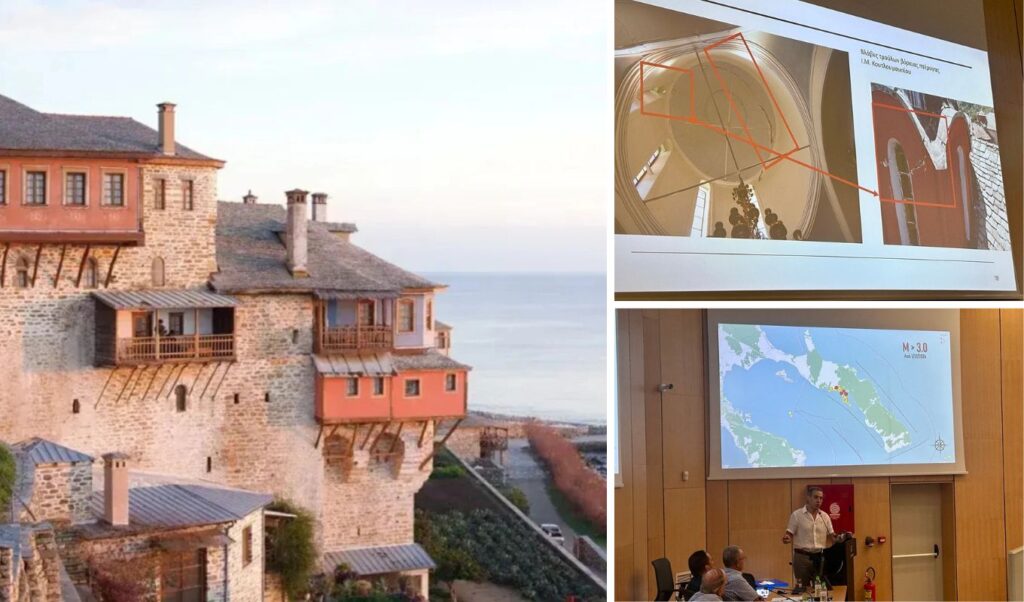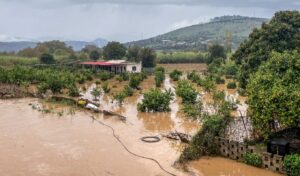Inspections at the monasteries of Mount Athos were conducted following the earthquakes of recent months, revealing damage to arches, domes, chimneys and masonry. Restoration work is in its early stages, while some minor repairs have already begun.
The situation is not considered dangerous according to the general consensus of scientists and organizations that conducted the inspections. “No alarm was raised” and one of the key factors in this outcome was the construction principles of these buildings, which, although some were built many centuries ago, possess their own anti-seismic technology that made them resistant to earthquakes much larger than recent ones, such as the magnitude 7+ earthquake in 1905.
Mount Athos: The damage map after monastery earthquakes
The damage recorded after monastery inspections following the recent seismic sequence at Mount Athos, along with restoration planning and further seismic reinforcement of buildings, was presented at a conference organized by the Central Macedonia Department of the Technical Chamber of Greece (TEE). Specifically, the work of a Working Group established by TEE/Central Macedonia, in collaboration with the Civil Engineering Department of Aristotle University of Thessaloniki, OASP-ITSAK and the Center for Preservation of Athonite Heritage (Ke.D.A.K), was presented to investigate seismic activity at Mount Athos and its impact on monumental structures.
TEE/Central Macedonia president: Expected damage, we know how to restore it
“Most problems were identified in monasteries closer to the earthquake epicenter. The most vulnerable structures are mainly the churches because they have domes, cupolas and tympana, which are sensitive to seismic activity. All the damage we observed was expected – nothing surprised us. We anticipated this based on earthquake magnitudes, we know how to restore them and will proceed immediately,” stated Ilias Pertsinidis, president of the TEE/Central Macedonia Governing Committee, adding that “in the immediate future we are preparing a proposal for restoring this damage and have secured funding to proceed further.”
Regarding the evolution of seismic activity in the area, he noted that “it’s somewhat strange that the phenomenon isn’t subsiding, but based on what we hear from seismologists, we don’t expect higher intensity earthquakes,” however “acceleration is also very important for us and June’s earthquake had very high seismic acceleration, yet the structures held firm.”
“Mount Athos structures have their own seismic technology despite the absence of anti-seismic regulations – as we know them today – at that time. Nevertheless, the people who built these structures had knowledge and constructed them following serious anti-seismic technology principles. Today we ‘read’ these buildings and intervene in ways that don’t alter their static system, but simply strengthen them. We’re in a very good position. We didn’t have serious damage,” clarified Mr. Pertsinidis.
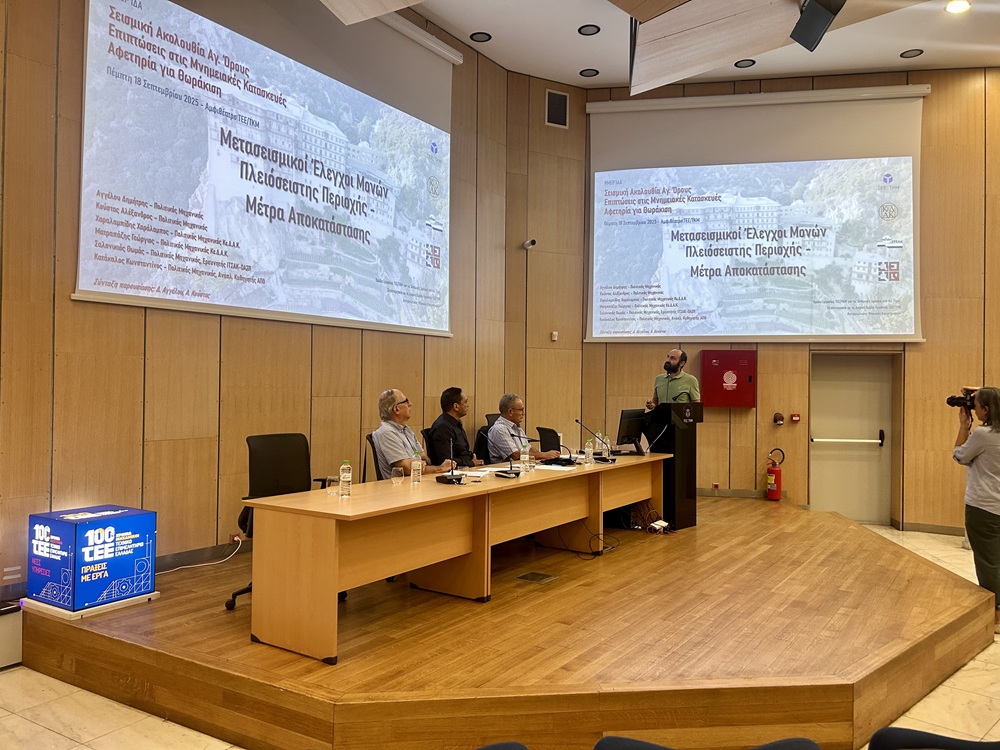
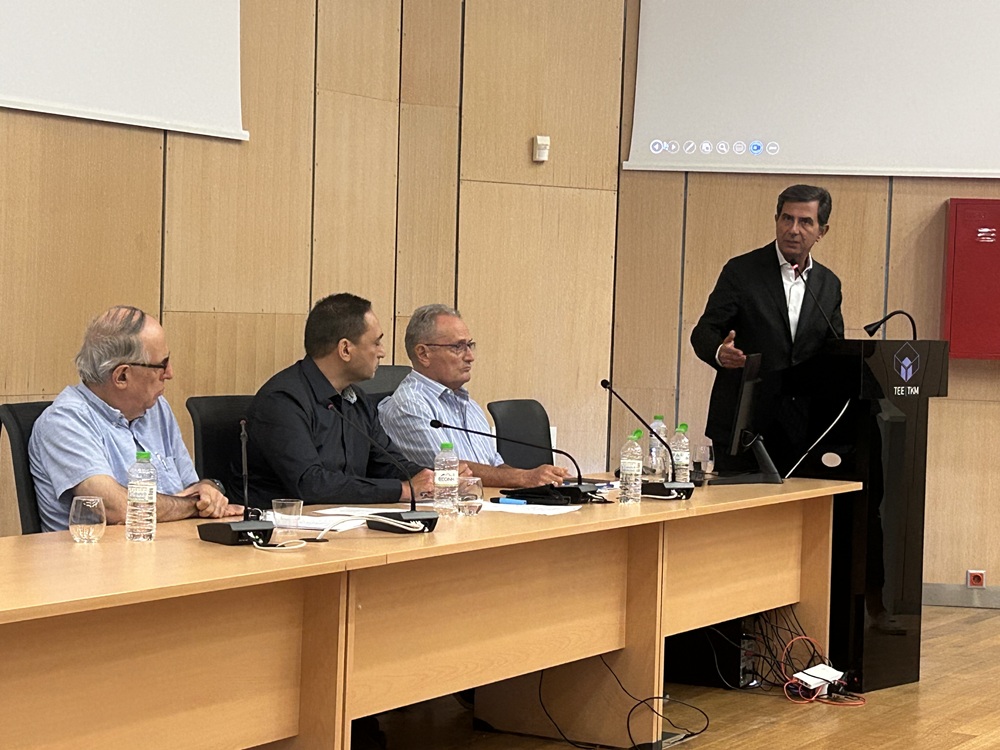
Up to 4,000 buildings under inspection at Mount Athos
“The earthquakes during this period were frequent, reaching a maximum of 5.3 on the Richter scale, and there was some damage, relatively localized, mainly at higher points of structures – cupolas, chimneys – but also lower areas in some monasteries, some closer, others farther from the epicenters,” stated Professor Emeritus Christos Ignatakis from AUTh’s Civil Engineering Department, head of the Working Group established by TEE/Central Macedonia to study seismic sequence impacts at Mount Athos.
“We also dealt with seismic history and how the area’s ground affects it, as well as damage assessment,” noted Mr. Ignatakis, adding that for pre-seismic inspection procedures, they adapted the program applied to all public buildings in Greece, “modifying procedures to make them suitable for Mount Athos buildings.” The pre-seismic inspection work at Mount Athos, he explained, is complex “considering that statically independent buildings – a complex may have four to five buildings, each examined separately – number around 3,000-4,000.”
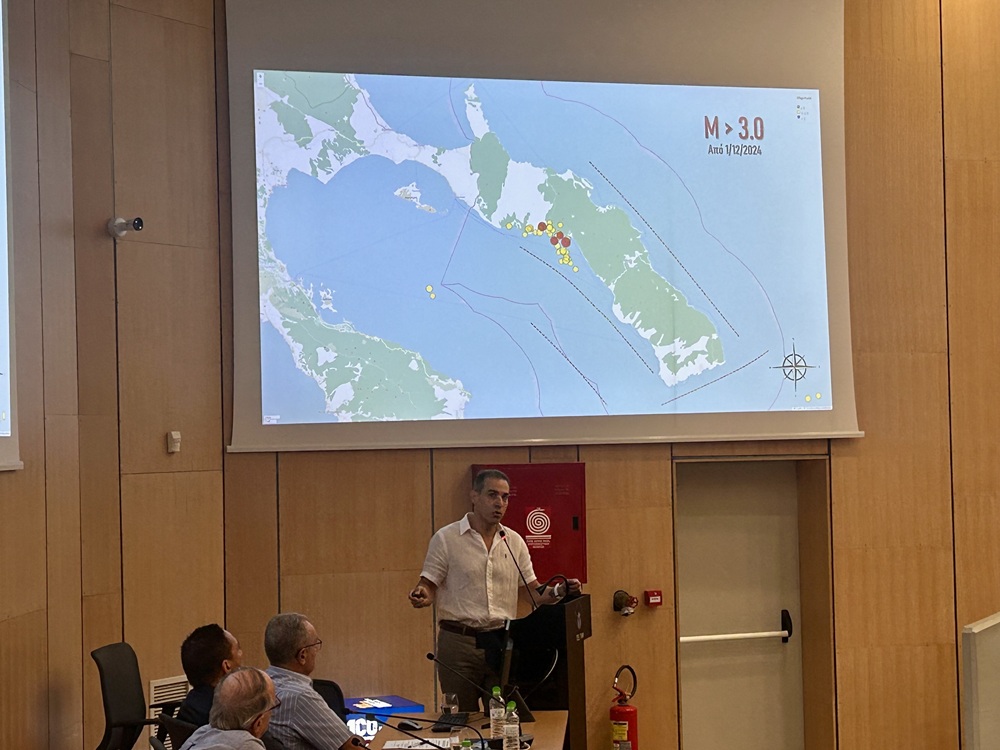
Regarding damage restoration, he noted that “it’s in its early stages – some monasteries are conducting studies, others have begun minor repairs,” however “the situation isn’t dangerous in any case, so no alarm was raised”. As highlighted in presentations by ITSAK-OASP Emeritus Researcher Vasilis Margaris, Associate Professor Vasilis Papanikolaou from the Civil Engineering Department, and Civil Engineer Alexandros Koustas, the main structural elements of Mount Athos buildings include various types of masonry, brick-built curved supports, timber-frame walls mainly on upper floors, wooden structures, and wooden ties, while metal supports and newer interventions are limited.
Of particular value, as emphasized, was the installation of accelerographs at four Mount Athos monasteries – at Saint Anna’s Skete, Great Lavra, Simonopetra and Vatopedi – providing precise data on accelerations and exact determination of areas and monasteries that received the greatest seismic energy. As revealed, Vatopedi Monastery, located perpendicular to the fault lines, “received the greatest acceleration,” noted Mr. Papanikolaou. “We collected all earthquake epicenters for this specific area – the region is clearly defined,” noted Mr. Margaris.
“The seismic sequence that occurred at Mount Athos from early 2024 emphatically reminds us of the particularity and dynamics of natural phenomena in our country. Over 1,800 earthquakes were recorded in the area, with the strongest being 5.3 on the Richter scale in June. Fortunately, damage recorded at the monasteries was limited. However, this challenge calls us to further strengthen prevention and protection measures,” noted Climate Crisis and Civil Protection Minister Ioannis Kefalogiannis in his greeting read at the event’s opening.
The event concluded with greetings from Interior Deputy Minister (Macedonia-Thrace sector) Konstantinos Gkiouleka, who heads Ke.D.A.K’s Administrative Council. “It’s our duty to protect our cultural and religious heritage, especially when it concerns Mount Athos, a unique global phenomenon,” he stated, adding that after damage assessment “we can now move to the second stage of intervention and repair,” and “regarding the central government, an amount has been approved by the Prime Minister himself from the first moment to immediately address initial needs, and certainly according to needs, if more money is required, it will be provided.”
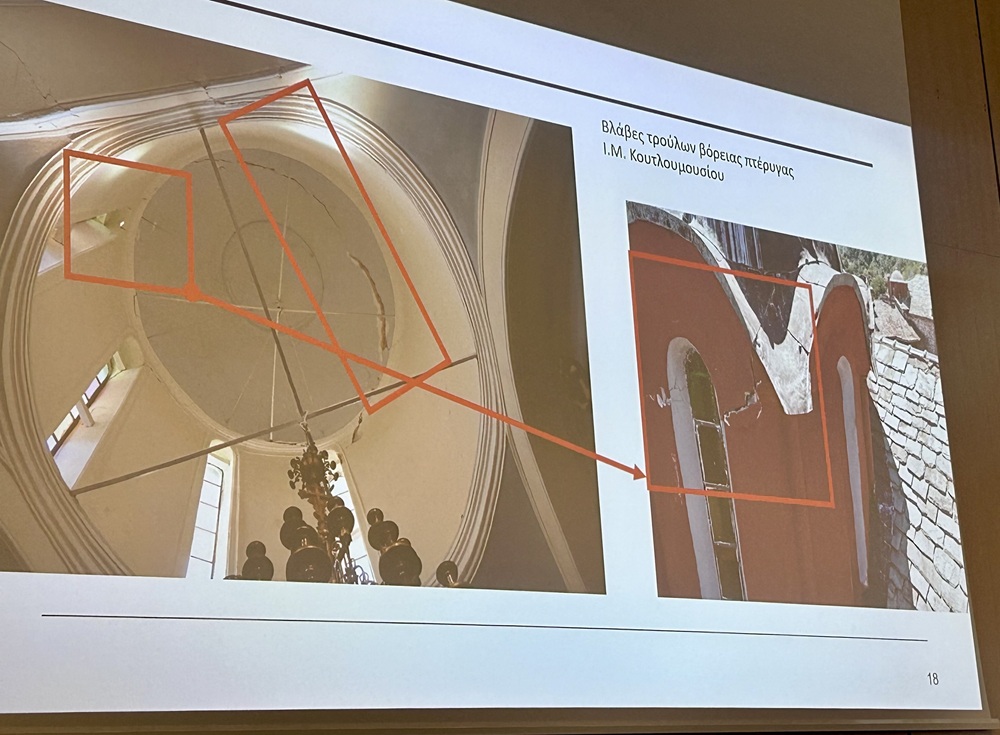
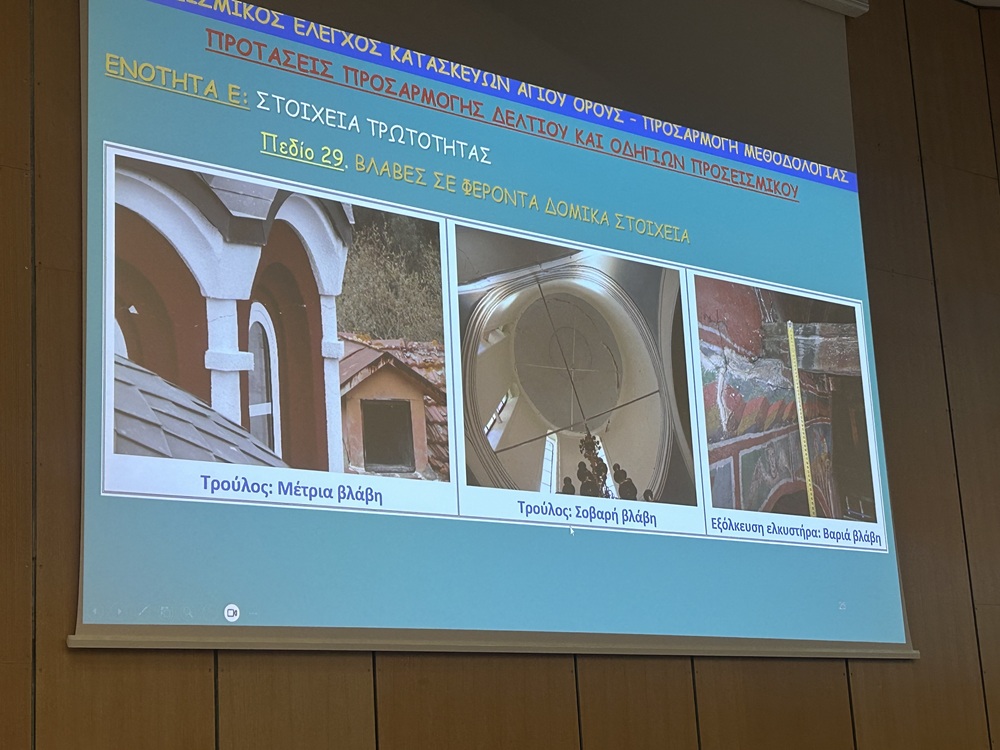
What inspections revealed after Mount Athos seismic sequence (Ke.D.A.K.)
1. Great Lavra Monastery: Cracks in masonry plaster at the archontariki
Saint Eustathios Cell – Mylopotamos: Cracks in masonry plaster at the Church
2. Vatopedi Monastery: Chimney section collapses and cracks in Saint Andrew’s old Church and office corridor
Saint Dimitrios Skete: Cracks and plaster falls from masonry
3. Iviron Monastery: Worsening of previous structural problems in the Exonarthex and Narthex of the Katholikon. Cracks in masonry plaster in corridors
Karyes Representative Office: Serious damage to the Church (dome, arches, spherical triangles, pillars), worsening previous damage, minor damage to internal masonry in the rest of the building, possible widening of previous cracks in building masonry
4. Hilandar Monastery: Heavy chimney damage at the Monastery. Minor damage to the Katholikon and wing masonry.
Saint Tryphon Cell: Serious Church damage (cracks in dome, tympanum, arches, pillars)
Saint Paisios Cell: Serious Church damage (cracks in dome, tympanum, arches, pillars)
5. Dionysiou Monastery: Minor to moderate damage in the Refectory and katholikon. Serious damage to chimneys and wooden balconies on the north facade
Saint Artemios Church – Monoxylitis: Serious Church damage (cracks in dome, tympanum, arches, pillars)
6. Koutloumousiou Monastery: Worsening of previous structural problems in the Katholikon’s Lite. Serious damage to two chapels on the north wing’s upper level (cracks in dome, tympanum, arches)
Holy Forerunner Cell – Dionysius of Fourna: Cracks in masonry plaster and chimney collapses
7. Pantokrator Monastery: Chimney collapses and other damage. Tower masonry cracks in various positions
Dormition of Theotokos Cell in Karyes: Extensive cracks in load-bearing stone masonry, mainly in the building’s eastern section, throughout its height. Immediate geotechnical and structural restoration studies recommended.
Prophet Elias Skete: Cracks in masonry plaster in the Church and building complex
8. Xeropotamou Monastery: Cracks in masonry plaster in the Katholikon and building complex
9. Zographou Monastery: Heavy chimney damage
Cemetery Church: Serious Church damage (cracks in dome, tympanum, arches, pillars)
Saint George Cell: Serious damage throughout the complex (Church, auxiliary buildings, surrounding area)
10. Docheiariou Monastery: Cracks in vaults, arches and masonry
11. Simonopetra Monastery: Cracks in vaults and arches, in areas above doors and between openings. Chimney damage. Masonry cracks. Damage to slate roof covering.
Saint George “Kalatha” Cell in Karyes: Cracks in masonry plaster and chimney collapses
12. Saint Paul Monastery: Heavy chimney damage at the Monastery. Possible minor damage to the Katholikon
Zarkadi Hermitage: Heavy damage with collapse of the SE corner of the hermitage, masonry cracks
13. Stavronikita Monastery: Cracks in masonry plaster and chimney collapse
14. Xenophontos Monastery: Cracks in dome tympana. Plaster detachment. Worsening of previous cracks.
15. Saint Gregory Monastery
Saint Gregory Monastery Representative Office in Karyes: Moderate Church damage in dome, arch, minor damage in masonry plaster
Saint Philotheos Cell in Karyes: Serious damage to the Cell’s NE corner
16. Esphigmenou Monastery:
Esphigmenou Monastery Representative Office in Karyes: Cracks in masonry plaster
Old Representative Office in Karyes: Chimney collapse and roof damage
Saint Tryphon Cell: Cracks and plaster falls from masonry and roof damage
17. Saint Panteleimon Monastery: Cracks in dome tympana and masonry. Chimney collapses, plaster detachment
18. Konstamonitou Monastery: Heavy chimney damage, serious damage to partition walls and plaster
Source: ANA-MPA

